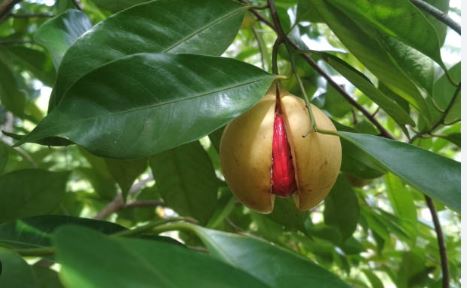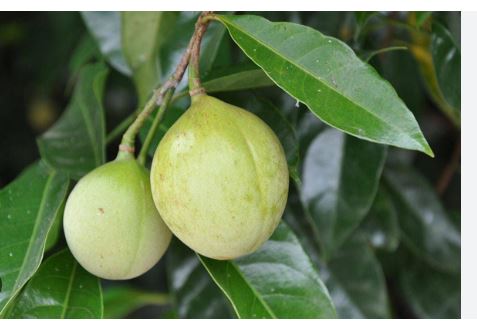
Nutmeg trees, cherished for their aromatic seeds and vibrant mace, are tropical evergreens that bring exotic allure to gardens and plantations. Native to the Moluccas of Indonesia, these trees thrive in hot, humid climates, producing pear-shaped fruits that yield the prized nutmeg seed and its red aril. Revered in cuisines worldwide, from savory dishes to festive desserts, they hold cultural significance, notably in Grenada, where nutmeg graces the national flag. Their glossy foliage and fragrant flowers add ornamental value to tropical landscapes.
Growing 30–60 feet tall, nutmeg trees are dioecious, requiring both male and female plants for fruit production, which begins after 7–9 years and peaks at 20–25 years. They flourish in USDA zones 10–12, needing well-drained, loamy soil, high humidity, and consistent moisture. Partial shade from companion crops like banana or cocoa protects young trees, while full sun boosts fruiting in maturity. Their long lifespan, up to 100 years, makes them a sustainable choice for tropical agroforestry.
Cultivating nutmeg trees demands patience, as fresh seeds must be planted immediately, and pollination relies on a female-to-male ratio. Harvested when fruits split, nutmegs are dried for weeks, while mace is processed separately, both offering culinary versatility. The trees’ shallow roots stabilize soil, and their canopy supports biodiversity by attracting pollinators like beetles. However, pests like fruit rot require vigilant management with organic solutions.
Nutmeg trees offer more than spice; their essential oils are used in perfumes and traditional medicine for digestive and pain relief, though high doses can be toxic. Their cultivation supports carbon sequestration, enhancing environmental health. Gardeners must protect seeds from pets due to toxicity. Intercropping with coffee or vanilla maximizes land use, creating vibrant, productive ecosystems.
To grow nutmeg trees, plant in fertile, loamy soil with a pH of 5.5–7.5, ensuring 60+ inches of annual rainfall. Space trees 30–40 feet apart, mulch to retain moisture, and prune lightly to encourage fruiting. Whether in a tropical garden or greenhouse, nutmeg trees reward dedication with decades of spice and beauty, connecting growers to a rich global heritage.

Why Nutmeg Trees Are a Tropical Treasure
Nutmeg trees are more than just spice producers; they’re evergreen marvels that thrive in hot, humid climates, offering glossy foliage, fragrant flowers, and edible fruit. Typically growing 30–60 feet tall, these dioecious trees (with separate male and female plants) require careful cultivation, as only female trees bear the nutmeg fruit. The genus Myristica includes the commercially dominant Myristica fragrans, but other species, like M. argentea and M. malabarica, play roles in local cuisines and medicine. Nutmeg trees take 7–9 years to fruit and peak at 20–25 years, yielding for up to 60–100 years, making them a long-term investment. Thriving in USDA zones 10–12, they demand well-drained, loamy soil and consistent moisture, ideal for tropical regions like Indonesia, Grenada, and Sri Lanka.
Nutmeg Trees
1. Common Nutmeg (Myristica fragrans)
Common Nutmeg, or fragrant nutmeg, is the most widely cultivated variety, native to the Banda Islands of Indonesia. This evergreen grows 30–60 feet, with dark green, glossy leaves and small, pale yellow flowers. Its pear-shaped, yellow fruit splits to reveal a shiny brown seed (nutmeg) wrapped in a crimson aril (mace). Producing 500–1,000 fruits annually, it’s the primary source of global nutmeg and mace, with Indonesia and Grenada leading exports. Thriving in full sun with afternoon shade, it prefers loamy soil (pH 5.5–7.5) and high humidity. Pair with banana or cocoa for shade in plantations. Common Nutmeg is perfect for gardeners seeking the classic spice duo for culinary and commercial use.
2. Papuan Nutmeg (Myristica argentea)
Papuan Nutmeg, native to New Guinea, is a lesser-known variety often used as an adulterant for M. fragrans products. Growing 40–50 feet, it features smooth, gray-brown bark and aromatic, leathery leaves. Its fruit lacks the intense flavor of true nutmeg, producing a milder spice used locally in Papua New Guinea. It thrives in deep, loamy soils with consistent moisture, tolerating partial shade. While not a commercial powerhouse, its resilience suits tropical gardeners experimenting with alternative nutmeg species. Plant with male pollinators for fruiting, and pair with kenari nut trees for wind protection. Papuan Nutmeg is ideal for those exploring regional spice cultivation.
3. Bombay Nutmeg (Myristica malabarica)
Bombay Nutmeg, native to India’s Western Ghats, grows 50–65 feet with glossy, lanceolate leaves and small, yellow flowers. Its fruit yields a seed with a less potent aroma than M. fragrans, used locally for medicinal purposes and as a spice adulterant. Preferring humid, shaded rainforests, it thrives in well-drained, organic-rich soil (pH 6–7). Its dioecious nature requires male and female trees for fruit production. Often intercropped with coffee or pepper, it suits agroforestry systems. Bombay Nutmeg is a great choice for gardeners in southern India or similar climates seeking a native spice tree with ecological benefits.
4. False Nutmeg (Myristica fatua)
False Nutmeg, found in Indonesia and Malaysia, is a smaller variety, reaching 30–40 feet, with aromatic leaves and inconspicuous flowers. Its fruit produces a seed with minimal flavor, used in traditional medicine rather than culinary applications. Thriving in lowland rainforests, it prefers moist, loamy soil and partial shade. Its compact size makes it suitable for home gardens or greenhouses in zones 11–12. Pair with shade-loving crops like ginger for intercropping. False Nutmeg appeals to gardeners interested in medicinal plants or biodiversity, offering a low-maintenance nutmeg species.
5. Macassar Nutmeg (Myristica inutilis)
Macassar Nutmeg, native to Sulawesi and New Guinea, grows 35–50 feet with dense, dark green foliage. Its fruit yields a seed with a subtle flavor, used locally as a spice or medicinal ingredient. It thrives in humid, tropical conditions with well-drained soil and tolerates light shade. Less commercially viable than M. fragrans, it’s valued for ecological restoration in its native range. Plant with male trees for pollination, and intercrop with vanilla for synergy. Macassar Nutmeg is ideal for gardeners in tropical Asia seeking a resilient, lesser-known variety.
6. Queensland Nutmeg (Myristica insipida)
Queensland Nutmeg, native to northeastern Australia, reaches 40–60 feet with glossy, aromatic leaves and small, cream-colored flowers. Its fruit produces a mild-flavored seed used by Indigenous communities for food and medicine. Thriving in rainforest conditions, it prefers deep, fertile soil and high humidity. Its adaptability suits coastal tropical gardens in zones 10–12. Pair with native Australian plants like macadamia for biodiversity. Queensland Nutmeg is perfect for gardeners in Australia or similar climates wanting a native spice tree with cultural significance.
7. Silver Nutmeg (Myristica beddomei)
Silver Nutmeg, endemic to India’s Western Ghats, grows 50–70 feet with silvery-green leaves that shimmer in sunlight. Its fruit yields a seed used in Ayurvedic medicine, with a mild spice flavor. Preferring shaded, humid forests, it thrives in loamy, well-drained soil (pH 5.5–7). Its striking foliage makes it ornamental as well as functional. Intercrop with cardamom for a lush understory. Silver Nutmeg is a top pick for gardeners in southern India seeking a visually stunning nutmeg variety with medicinal value.
8. Broad-Leaved Nutmeg (Myristica dactyloides)
Broad-Leaved Nutmeg, native to Sri Lanka and Malaysia, grows 40–55 feet with wide, glossy leaves and small, fragrant flowers. Its fruit produces a seed with a delicate flavor, used in local cuisines and traditional remedies. It thrives in humid, shaded conditions with rich, loamy soil. Its broad canopy suits agroforestry, providing shade for crops like cocoa. Broad-Leaved Nutmeg is ideal for gardeners in Southeast Asia wanting a versatile nutmeg tree for spice and shade.
9. Swamp Nutmeg (Myristica hypargyraea)
Swamp Nutmeg, found in Indonesia and Papua New Guinea, grows 30–50 feet in lowland, waterlogged soils. Its fruit yields a seed used locally for mild seasoning or medicinal purposes. Unlike most nutmegs, it tolerates wetter conditions, making it unique for swampy tropical gardens. Plant in full sun with organic-rich soil, and pair with taro for wetland systems. Swamp Nutmeg is perfect for gardeners in flood-prone areas seeking a hardy, unconventional nutmeg variety.
10. Philippine Nutmeg (Myristica philippensis)
Philippine Nutmeg, native to the Philippines, reaches 35–50 feet with dense, aromatic foliage and small, yellow flowers. Its fruit produces a seed with a subtle flavor, used in local dishes and herbal medicine. Thriving in humid, well-drained soils, it prefers partial shade and high rainfall. Intercrop with coconut for a tropical plantation aesthetic. Philippine Nutmeg is a great choice for Filipino gardeners or those in similar climates wanting a native spice tree with culinary potential.
11. Solomon Nutmeg (Myristica ceylanica)
Solomon Nutmeg, native to the Solomon Islands and Sri Lanka, grows 40–60 feet with glossy, lance-shaped leaves. Its fruit yields a seed with a mild, nutmeg-like flavor, used in Pacific Island cuisines. It thrives in deep, loamy soil with consistent moisture and tolerates light shade. Pair with breadfruit for a tropical food forest. Solomon Nutmeg is ideal for gardeners in Pacific regions seeking a culturally significant nutmeg variety for local dishes.
12. California Nutmeg (Torreya californica)
California Nutmeg, a non-Myristica species from the Taxaceae family, is included for its nutmeg-like seeds, though not a true spice source. Native to California, this coniferous evergreen grows 15–50 feet with sharp, needle-like leaves and edible, nutmeg-shaped seeds used historically by Indigenous peoples. Thriving in USDA zones 7–9, it prefers well-drained, slightly acidic soil and partial shade. Its shade tolerance suits forest gardens with redwoods or Douglas fir. California Nutmeg is perfect for North American gardeners seeking a native, nutmeg-like tree for ornamental and historical value.